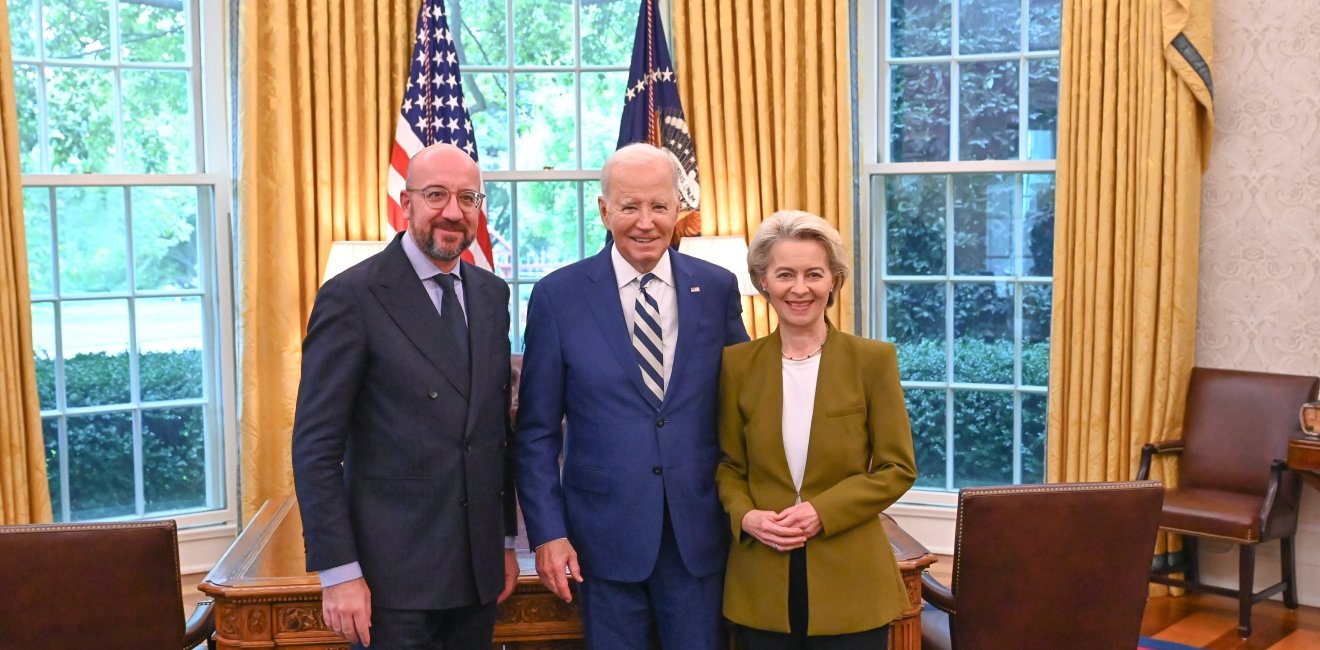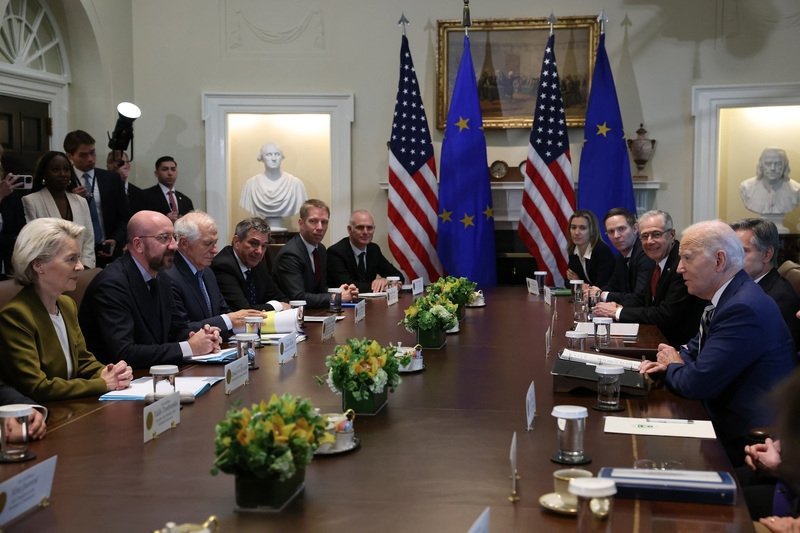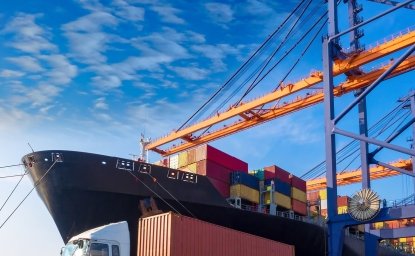The US-EU Summit in Washington: Did it Meet Expectations? – Expert Quick Takes
In this article, our experts analyze the US-EU Summit’s outcomes and deliverables and what they mean for the future of US-EU relations.
In this article, our experts analyze the US-EU Summit’s outcomes and deliverables and what they mean for the future of US-EU relations.

After a two year gap, US President Joe Biden, European Commission President Ursula von der Leyen, and European Council President Charles Michel met in Washington last week for the US-EU Summit. The last summit in Brussels in 2021 renewed the resolve for strengthening the transatlantic partnership, resulting in the establishment of the Trade and Technology Council (TTC), among other things . Since then, the US and the EU have been working closely together across a range of policy areas, including financial and military support for Ukraine. Much less tangible success, however, has been achieved on trade and green technology issues. Expectations were high for the US and EU to resolve these issues at this summit, with next year’s US and European Parliament election looming. Did the summit deliver on its objectives?
In this article, our experts analyze the summit’s outcomes and deliverables and what they mean for the future of US-EU relations.
War and instability were the most prominent issues on the US-EU Summit agenda. President Biden returned to meet with EU counterparts after his whirlwind trip to the Middle East. A joint statement affirmed their condemnation of the attacks by Hamas and concern over the humanitarian crisis in Gaza; it also underscored the importance of continued financial, military, and humanitarian support for Ukraine. But the message also included pressing for reparations from Russia, along with strong signals to China to support resolution of the conflict, to address global challenges, and underscored the principles of territorial sovereignty.
The agenda was markedly different from the last summit in June 2021. The inability to reach any form of agreement on critical minerals, steel and aluminum tariffs, and green subsidies meant the summit had few specific deliverables. Despite US pressure on Europe to levy similar steel and aluminum tariffs on China, divisions remained due to European concerns about international trade rules. Europe is seeking greater access to subsidies under the US Inflation Reduction Act (IRA) especially given pressure faced from Chinese competitors. However, these transatlantic efforts also reveal that perceived regulatory differences over labor and environmental conditions across supply chains have stymied agreement on critical minerals.
As the US and EU chart their respective trade and climate strategies, less visible is the continued dialogue between the private and public sectors, and joint efforts by stakeholders across diverse industries on artificial intelligence. The rapid pace of development of artificial intelligence (AI) technologies has generated intense debate and varying policy responses in the EU and the United States. While the EU moves forward on legislation on AI, having deliberated over a strategy since 2018, the Biden administration is expected to use existing tools as Congress debates how to move forward with legislation on AI policy issues through federal antitrust regulation. Sustained efforts to act collaboratively and responsively are needed given the increasingly central place AI will play in digital infrastructure. Outreach to big tech companies is also critical amid concerns about the impact of a non-democratic state (such as China) setting the rules on AI governance.
One issue that has come roaring back is EU enlargement and its role in territorial sovereignty, political stabilization, and economic reform. The war in Ukraine along with candidate status for EU membership will also require post-war reconstruction efforts that will involve not only foreign aid but also democratic reforms and rule of law commitments. Enlargement had seemingly stalled–yet the political momentum is now back. The US-EU Summit with its reference to Moldova and Ukraine signaled the political imperative for continuing this path. In recent years, the Western Balkans have been marginalized as Europe and the United States have focused attention elsewhere. Yet the actions of the EU in recent weeks towards the Western Balkans regarding selective access for companies to the single market and support for the green and digital transformation in exchange for domestic reforms has not garnered enough attention. Such market incentives–coupled with the release of the commissioned Franco-German working group report on EU institutional reform–highlights the shift in strategic thinking in Europe. Given that some of these countries saw their membership prospects initiated 20 years ago, the decision to grant candidate country status to Moldova and Ukraine in 2022 has put the issue back on the transatlantic agenda. Though enlargement is a European decision, the transatlantic relationship has a common incentive to deal with the resolution of remaining regional disputes, particularly the normalization of Serbian-Kosovo relations, democratic backsliding, and the influence of Russia in the region.
One morning my brother stopped by my dorm room in college. We chatted by the door. As he left, a floormate asked what my brother was so upset about. I replied, nothing, that is just the way our family of seven spirited siblings communicate. So it is with the US and the EU. Just as my family remains close amid our spirited dialogues, so too it is important that the transatlantic alliance remains strong. The recent summit between President Joe Biden, European Council President Charles Michel, and European Commission President Ursula von der Leyen succeeded in presenting a united front despite unresolved matters related to steel and energy credits.
Among the many shared challenges is the People’s Republic of China (PRC) that has gained monopolistic positions in industries of the future, including critical minerals, batteries, solar panels and telecommunications equipment. This has been achieved by applying significant subsidies and excess industrial capacity towards dominating global markets. Then it applies profits gained from supremacy in these industries to subsidies directed towards achieving dominance in new industries.
Next up, electric vehicles (EVs). One analyst says China’s automobile industry has enough excess capacity to supply the entire Japanese car market—twice. The PRC continuing to invest in additional steel capacity even as there is a global gut in capacity.
The credits in the Inflation Reduction Act can be thought of as an attempt to blunt the impact of the PRC’s subsidies and excess capacity in critical minerals, EVs, batteries, and solar. Yet by implementing credits in a manner that harms allies, it undermines the benefits of unity of action.
The EU is taking a different approach to advancing climate goals—a Carbon Border Adjustment Mechanism (CBAM). These differing approaches to achieving the same goal are destined to cause friction. Aligning effort on at least steel and aluminum would help mitigate this friction.
Taken together these negotiations are not one-sided. A deal would require both sides to bend. Yet there are vocal opponents to bending on both continents. With the EU parliament elections in June and the US elections in November 2024, these issues will be easier to resolve after both elections.
Meanwhile, there are many matters that cannot be deferred. Unity of action in the Middle East and Ukraine is essential. Those making baseless excuses for not supporting Ukraine are making this more challenging. Both the US and EU are committing to ensuring there is Russian “compensation for the damage caused to Ukraine”, yet have not found a way to use Russia’s frozen assets. This can only be accomplished with unity of action.
The superpower of the Atlantic alliance is unity of action. Despite differing approaches and interests, both sides should recognize that doing the hard work to achieve unity is essential for effective action on the most important shared challenges we face.
The 2023 EU-US Summit came at a crucial time for the transatlantic relationship as conflicts are persisting and new ones are unraveling. That is why confirmation of and unison in the positions of the United States and the EU in their commitment to democratic values, multilateralism, and international law was highly anticipated. One of the important outcomes of the summit was the confirmation of the continuous transatlantic commitment to supporting Ukraine in its war with Russia, which was achieved alongside a united front towards the ongoing conflict in Israel. This commitment to supporting \Ukraine is important in the face of growing concerns among the Ukrainian public of “western fatigue”, a strong propaganda campaign stemming from the Kremlin.
The two sides reaffirmed the centrality of NATO for Euro-Atlantic security with a joint recognition of the need for a stronger European defense. In addition, the EU and the US reaffirmed their commitment to regional stability and conflict resolution in key regions for the EU, including the Western Balkans and the South Caucasus.
A topic that should be observed further is the European position on China. Various policy and member-state divides on China have dominated the political landscape in the EU over the past months, indicating the complexity and overall lack of clarity on the EU’s approach towards Beijing. Moreover, the summit talks occurred shortly after Hungary’s Prime Minister Viktor Orban met with Russia’s Vladimir Putin and China’s Xi Jinping at the third Belt and Road Forum in Beijing last week as the sole EU head of state in attendance. Nevertheless, in their joint statement following the summit, the EU and the US pushed China to take a clear stance on Russia’s war of aggression and pressure Moscow to withdraw its forces from Ukraine.
A curious detail that raised eyebrows last week was the EU’s decision for the Commission and Council Presidents to hold separate meetings with President Biden during the summit. It led to speculation about possible disunity in the EU leadership–and its approach to key foreign policy issues.
The 2021 US-EU Summit marked a renewal of transatlantic relations after a period of stagnation. The last US-EU Summit was in 2014 and this was the first time a US President had visited the EU institutions since 2017. On the agenda in 2021: post-COVID recovery and removing trade irritants.
Now, the second US-EU Summit comes at a time of less economic uncertainty but of unprecedented conflict, with unexpected violence in Israel adding a new wrinkle to sustained support for Ukraine. President Biden needed to show European partners the US would continue to provide strong support for Ukraine. The strong language in the joint statement released on Friday underscores the continued US-EU commitment to supporting Ukraine. Together, the EU and the US are the two largest contributors of aid, their financial and economic backing have been critical to the Ukrainian war efforts. Taken together, assistance from the EU institutions and its member states plus the United States represent over 80% of the total aid provided to Ukraine.
Despite strong rhetoric in the joint statement, difficult times lie ahead and support for Ukraine is not guaranteed. With no end to the conflict in sight, Putin is counting on international support for Ukraine to fade and for transatlantic unity to falter. It is imperative that the US-EU Summit format continues, regardless of potential changes in US leadership, to demonstrate continued support for Ukraine in its time of crisis.
The transatlantic alliance is experiencing its greatest test in decades. The US-EU Summit demonstrates the Russian invasion of Ukraine has profoundly revitalized and re-energized US-EU relations and much work lies ahead in supporting Ukraine.
The last US-EU Summit in 2021 was celebrated as the renewal of a strong transatlantic partnership. It set up an ambitious agenda for trade, climate and technology cooperation. After two years of regular TTC meetings, the expectations were high for this year’s summit to achieve a breakthrough on the critical minerals agreement and the Global Arrangement on Sustainable Steel and Aluminum (GASSA)—yet the results have left much to be desired. Because both sides failed to deliver agreements on these trade related issues, the center stage was given to foreign policy issues (noticeably in the actual text, compared to the last joint statement), exacerbated by concerns of a broader regional conflict in the Middle East.
In response to recent tensions in the EU's immediate neighborhood, the statement acknowledges the “strategic importance” of the EU enlargement policy for regional stability, especially in the Western Balkans. However, both sides fell short of committing to concrete, proactive steps to coordinate policies for the Western Balkans region—necessary for short term de-escalation efforts, especially between Kosovo and Serbia, as well as for building long term capabilities for regional stability. Both sides also renewed their support for Ukraine and its European path for “as long as it takes''—a crucial commitment for the EU.
Although the joint statement, therefore, strives to portray that the transatlantic partners are “more united than ever”, domestic debates, in both the US and the EU, on their respective roles in the world, show the fragility of unity. Even before the serious deterioration of the situation in Gaza, US domestic deliberations on whether to continue supporting Ukraine have been making EU policymakers nervous. On the other hand, the EU has sent mixed messages in response to Hamas’s attack in Israel, resurfacing the old struggles of the EU’s capability to act as a strong, unified global actor.
After Friday’s meeting, the attention quickly shifted to the end of the year, as the US and EU “look forward to continuing to make progress” on trade related issues. However, with both sides facing elections next year, this summit, unfortunately, missed the opportunity to bring some stability and predictability to the future of transatlantic cooperation.

Last week’s US-EU Summit was never going to fail. The urgency of presenting a united front on Ukraine, the Middle East and China assured that. But on two important trade issues President Biden’s meeting with European Commission President Ursula Von der Leyen and European Council President Charles Michel delivered only disappointment.
On China, Russia, Africa, and technological cooperation, the results of the summit were encouraging. But US-EU congeniality traditionally flounders on the field of trade and this was the case once again. The two sides failed to bridge differences in their negotiations for a Global Arrangement on Sustainable Steel and Aluminum (GASSA) and for an agreement on critical raw materials that would have enabled closer cooperation on the production of EVs.
GASSA would address China’s non-market steel production and trade practices and encourage clean, sustainable manufacturing. The idea is to establish a “club” of steel producing nations which abide by market principles and produce steel and aluminum sustainably. Members of the club would be exempt from high duties while China’s juggernaut mills would face 25% tariffs on steel and 10% on aluminum.
Before acting against China, the EU wants to investigate the extent to which Chinese producers benefit from subsidies and from predatory pricing in the EU market. This approach would be consistent with WTO rules, but the US feels no obligation to follow this path.
The two sides also differ significantly on how to address emissions. The US is tackling climate change through vast subsidies to green technologies including EV production. The EU also subsidizes green tech but, in an effort to prod other nations to clean up their act in the production of steel (and five other industries) it will also begin applying import duties on high emissions production. The Carbon Border Adjustment Mechanism (CBAM) tracks the price of carbon in the market and applies a duty commensurate with the levels of emissions produced. Exporting countries using a similar system of carbon pricing would face lower EU border charges. The United States is one of the few countries with no nationwide system of carbon pricing so US steelmakers would be hit with EU tariffs. Washington believes it should have special dispensation exempting US producers from the duties. The EU argument that such favored treatment violates WTO rules falls on deaf ears in Washington.
The Europeans have not yielded to intense US pressure on CBAM and it’s unlikely that they will. So, the US is exploring its options through a study at the US International Trade Commission which will issue the report in January 2025.
The concluding communique sets the end of year as a target for making progress but fixes no firm deadline for agreement. With EU and US elections on tap for 2024, the political climate for compromise on trade will not be ideal.
The EU also sought to broker an agreement on critical raw materials which would have enabled European companies to benefit from the tax breaks extended in the US Inflation Reduction Act. Currently such benefits extend to carmakers, battery producers, and other companies from countries with which the United States has a trade agreement. Although the EU is one of America’s largest trading partners there is no trade agreement between the two. Earlier this year, the United States signed a critical minerals trade agreement with Japan and Brussels had hoped for a similar accord. It was not to be. Instead, the parties pledged to “make progress” on this front in the coming weeks.
Why did these agreements, seemingly within reach just a week ago, fall apart? One suggestion is that rancor between trade negotiators on the two sides soured the environment for making concessions. The EU was furious that duties applied on European steel and aluminum by the Trump administration and suspended by President Biden were not permanently rescinded. European negotiators were further irritated by suggestions that the minerals agreement should not go through because of substandard labor standards in some companies from which EU carmakers source their materials.
The good news is that there seems to be genuine interest in reaching agreement. US officials lowered the temperature as well by making clear that there is no prospect that the Trump tariffs will be re-imposed any time soon. But the fact remains that reaching a deal by year end will be a tall order. Moreover, the political pressures in an election year make a deal in 2024 unlikely. On the big picture issues, the US-EU Summit delivered an important show of solidarity but on the trade front it was an opportunity missed.
Emerging technologies are a key part of geopolitical conversations this year, and the joint statement issued after the US-EU Summit largely affirmed the role of the Trade and Technology Council (TTC) in driving collaboration and addressing common challenges. The statement highlighted an intense focus on protecting technology as a lever of democratic values, with three major areas of concern: limiting access to advanced technologies and key materials, including through export controls; charting a course for artificial intelligence (AI) for public good; and combating disinformation in a key global election season.
The statement showed little change in the disparate approaches of the EU and United States, nor convergence on interests. As we confront the ongoing hostilities in Ukraine– among other authoritarian or adversarial uses of technology–the statement clearly preserves strong policy levers for both the EU and US to limit access to technology and materials where we feel it is central to defending democratic values. Export controls were explicitly noted as a policy tool to be used, but we can anticipate the EU’s sensitivity around the impacts of US activity on the EU’s competitive footprint to continue to be a point around which we must carefully navigate.
As with everything, AI was a central node of discussion. On AI, while both sides agree on the values that should underpin management of AI, the tensions between the EU’s inclination toward regulation and the more industry-friendly environment promoted by the US are evident. The EU’s AI Act continues to wind its way through the member negotiation process following its adoption by the EU Parliament, but the process is far from done. Policymakers will likely continue to have governance conversations that touch on the facets of AI, namely generative AI capabilities, that have grown in importance since the drafting of the act. These conversations, and the AI Act itself, will likely influence US policy discussions, but the United States seems primarily ready to rely on stakeholder groups to set standards and major legislation is not expected, keeping the United States out of sync with EU governance aims. Perhaps reflective of a balancing of government-led regulation versus industry-informed decision-making, the joint statement notes the importance of working with a wide group of stakeholders, including industry, civil society, and academia in advancing responsible innovation and trustworthy development.
Disinformation stands as the most direct use of technology to attack democratic values and was referenced in multiple prongs of the statement. The EU’s cybersecurity agency recently warned that increased availability and adoption of AI tools is fueling a stronger wave of disinformation, leading to more polarization of debate and possible foreign influence or interference in elections. Collaboration between the EU and US on this point may be difficult, with the United States’ robust emphasis on freedom of expression and speech making the domestic conversation tricky. Action to address disinformation will make the larger discussions with AI stakeholders ever more important, as industry seeks to create technical solutions to marking generated content or limiting bot networks spreading false or misleading information.
The summit was an important step in reaffirming the transatlantic partnership on trade and technology, but we can expect continued discussions on how we square our differentiated approaches to regulation and innovation as we build strong democratic values into global use of technology as well as how we limit its use in undermining global peace and security.
The 2023 EU-US Summit showcased the increased engagement between the US and the EU on trade—the transatlantic partners now have “shared interest in reforming” the World Trade Organization’s (WTO) dispute settlement system—the Appellate Body—by the next Ministerial Council (MC) in February 2024.
Reviving the WTO’s dispute settlement system shows the strong commitment of both parties to cooperate together on trade, where China is now perceived as the main challenger to the rules-based international order. The US and the EU share concerns regarding China’s use of unfair trade practices, such as state subsidies. The US has been particularly concerned by China distorting the steel and aluminum markets; the EU also recently opened an investigation into Chinese EV exports. The US and the EU are wary of China's growing clout in critical sectors for the green transition—transatlantic cooperation is seen as an optimal way to address this.
Reviving the WTO’s Appellate Body will be crucial for the EU and the US to get the Global Arrangement on Sustainable Steel and Aluminum (GASSA) right—the proposed steel and aluminum club by the EU and the US to tackle unfair trade practices. This also shows transatlantic commitment to the rules-based international trade regime, for which the re-establishment of the WTO's Appellate Body is crucial—as well as for the long-term viability of the whole organization.
Although this opening is a positive signal of the US and the EU wanting to tackle deeper trade disagreements, finding a solution before MC13 will be a difficult task. However, both sides see the value in the WTO and its ability to continue playing a central role in resolving trade disputes.










The Global Europe Program is focused on Europe’s capabilities, and how it engages on critical global issues. We investigate European approaches to critical global issues. We examine Europe’s relations with Russia and Eurasia, China and the Indo-Pacific, the Middle East and Africa. Our initiatives include “Ukraine in Europe”—an examination of what it will take to make Ukraine’s European future a reality. But we also examine the role of NATO, the European Union and the OSCE, Europe’s energy security, transatlantic trade disputes, and challenges to democracy. The Global Europe Program’s staff, scholars-in-residence, and Global Fellows participate in seminars, policy study groups, and international conferences to provide analytical recommendations to policy makers and the media. Read more


The Wahba Institute for Strategic Competition works to shape conversations and inspire meaningful action to strengthen technology, trade, infrastructure, and energy as part of American economic and global leadership that benefits the nation and the world. Read more



